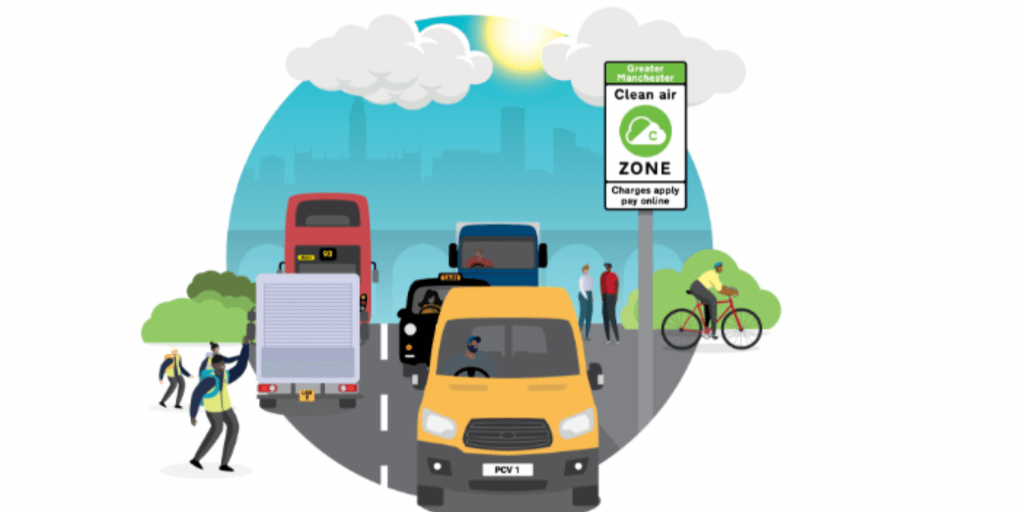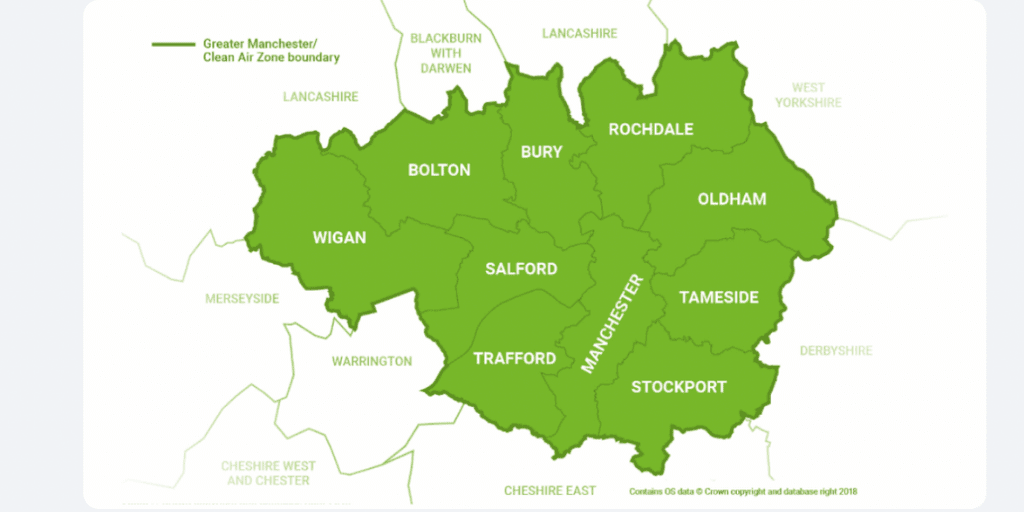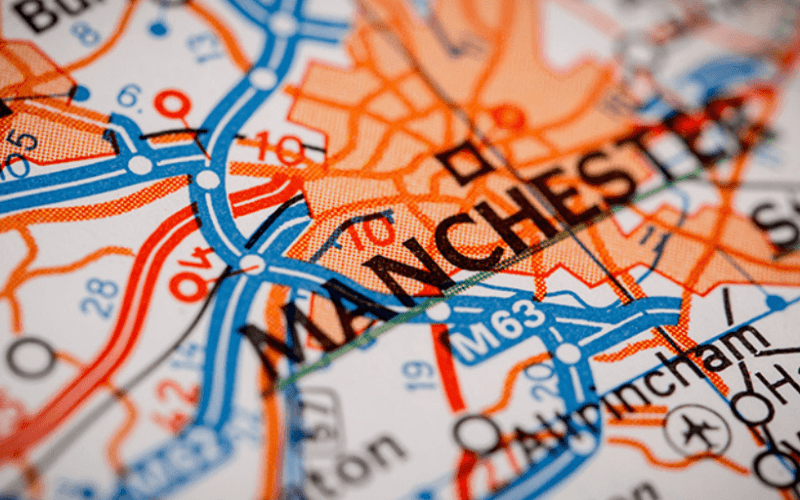Greater Manchester (GM) is taking action to improve air quality on all local roads. Next year, Manchester will launch its ‘Clear Air Zone‘ to help tackle the air pollution problem. The main source of air pollution in GM is road transport – contributing to 1200 deaths a year.
This change will affect many businesses travelling to and through GM and there are various regulations to be aware of. After all, if you don’t learn what GM Clear Air Zone is, you could receive some costly fines in the future.
Don’t worry though, in this post we’re going to explore everything you need to know about Greater Manchester’s Clean Air Zone. We’ll dive deep into what, why and when it’s happening and more so you can start preparing today.
We’ll cover:
- What is Greater Manchester’s Clean Air Zone?
- Why is it Happening?
- When is it Happening?
- Who Will Be Affected by Greater Manchester’s Clean Air Zone?
What is Greater Manchester’s Clean Air Zone?
GM Clean Air Zone has been introduced to help bring nitrogen dioxide (NO2) levels on local roads within legal limits by 2024. Clean Air Zones have been identified by the government as a way to help improve air quality in the most time-efficient manner.
Clean Air Zones are certain areas of the UK that take control to target and improve air quality for all. Resources are prioritised in these areas to shape the urban environment – delivering health benefits and supporting economic growth for the long term.

The regulations in place will encourage vehicle owners to upgrade to cleaner vehicles or pay a daily charge. This won’t be the same as a typical Congestion Charge where the majority of vehicles are charged to drive.
All ten local authorities have worked together to develop the Greater Manchester Clean Air Plan and councils are working hard to protect the planet. Greater Manchester’s Clean Air Zone is a positive change that’ll impact everyone for the right reasons. However, it’ll require some work and adjustments to various businesses, industries and vehicle owners that will be affected.
Why is it Happening?
Air pollution is a growing concern and GM is one of the WORST cities in the UK for poor air quality. The air pollution in Manchester includes dangerous levels of toxic pollutants that have a devastating impact on health..
In 2019, it was reported that air pollution was costing the GM economy £1BILLION annually. Greater Manchester’s Clean Air Zone will help prolong the health of others and it’ll improve air quality.
This development has been in the works since 2018 when a Strategic Outline Case was submitted to the government. 152 stretches of road in GM were identified and connected to the breach of legal limits for nitrogen dioxide (NO2) if further action wasn’t taken.
GM is now taking action for a safer and healthier future for all. But when is it happening? When do businesses need to prepare and is there a solid date to be aware of?
When is it Happening?
The Greater Manchester Clean Air Zone will launch on Monday 30th May 2022. The Clean Air Zone will operate seven days a week, 24 hours a day and 365 days a year. It’ll cover most of the roads in GM and it’ll only commence on the launch date – not before.
Preparations are being made now. Businesses are encouraged to make changes to their operations and vehicles this year to help with the move in May 2022. This isn’t a compulsory change, however, if adaptations are made before May 2022, they’ll save a lot of money in the long run – whilst also making a positive impact on the environment.
Air pollution isn’t a problem that’s going away anytime soon and changes have to be made for the future. If they’re not, businesses, organisations and people will experience the negative knock-on effects.
The timing of this development has been criticised, as some companies may need to invest a lot of money upfront to make the change. However, the long-term benefits of becoming more environmentally friendly will be worth it and will help many businesses and organisations save money.
Who Will Be Affected by Greater Manchester’s Clean Air Zone?

Many areas of GM will be affected by this change (refer to the map for specific locations). However, most roads that are managed by Highways England (as well as motorways and trunk roads) will not be included – with a few exceptions.
The areas that’ll be impacted and the vehicles that’ll be charged are set by the government in its Clean Air Zone Framework. The vehicles that’ll have to pay a daily charge (if they don’t meet the emission standards) are:
- Light goods vehicles (vans, minibuses, motorised horseboxes and motorhomes).
- Heavy goods vehicles (rigid lorries, motorhomes and horseboxes over 3.5t).
- Buses.
- Coaches.
- Hackney cabs.
- Private hire vehicles (black cabs).
- Minibuses, coaches, buses (more than 16 passengers).
The owners of non-compliant vehicles will have to pay a daily charge if they’re travelling through specific areas of GM. These payments will be made through the government online charging service.
Some of the charges that’ll apply cover the following:
- Buses and heavy goods vehicles (HGV): £60, from 30 May 2022.
- Coaches: £60, temporary exemption until 1 June 2023.
- Taxis and private hire vehicles: £7.50, from 30 May 2022 temporary exemption for GM licensed vehicles until 1 June 2023.
- Light goods vehicles (LGV) such as vans and minibuses: £10, temporary exemption until 1 June 2023.
If the daily charges aren’t paid, there’ll be a liability to pay (£120) in addition to the daily charge – this could be reduced to £60 if paid within a 14-day time frame.
The vehicles that aren’t included within the Clean Air Zone charges are private cars, motorbikes and mopeds. These vehicles will be able to travel without any other costs or charges.
There’ll be some local temporary and permanent exemptions implemented for the Greater Manchester-wide Clean Air Zone. Non-compliant vehicles will be able to apply for a temporary exemption from January 2022, so keep your eyes peeled for more updates.
Get Prepared Today
There’s never been a better time to weigh up different options and to explore different areas of development for your business. Before 2022, it’d be great to be prepared for the big change and to develop your business and move forward in the right direction for the future.
Investing in an electrical vehicle(s) is a great way to reduce your carbon footprint whilst also minimising the hidden costs you’ll receive. There are many other options you can choose to reduce your impact on the environment – vehicle leasing and rental options.
If you have any questions about how you can make your fleet more compliant or how you can start making positive changes today, get in touch with our team at CoolKit and we’ll be able to answer any questions you may have.

